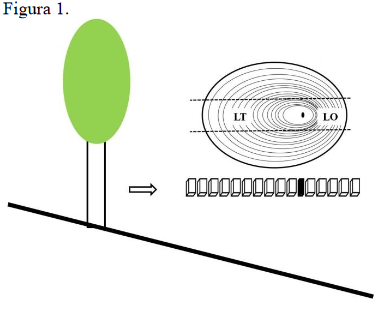Influência do lenho de tração nas propriedades físicas da madeira de Eucalyptus sp.
DOI:
https://doi.org/10.20873/jbb.uft.cemaf.v1n1.monteiroKeywords:
basic density, shrinkage, reaction wood, pith-bark directionAbstract
The reaction wood is formed in an attempt to remain upright tree in response to the action of forces such as winds, irregular crown or slope of the land that tend to incline it. In hardwoods, as in Eucalyptus, this type of wood is called tension wood and occurs in the region of the stem facing the face of force application. Indicative of the presence of this type of wood is the high shrinkage and basic density compared to normal wood. Once the basic density and shrinkage are parameters for determining the quality of the wood, this study aimed to evaluate the variation of basic density and shrinkage of opposite and tension wood along the radius in four species of Eucalyptus sp. Four tree species Eucalyptus camaldulensis, Eucalyptus maculata, Eucalyptus pilularis and Eucalyptus urophylla, with 32 years of age, were taken from an experimental planting of the Federal University of Lavras. Specimens were made to represent the diametrical variation of the opposite of tension wood in disks cut at the dbh. The results indicate that the properties of radial, tangential and volumetric shrinkage, coefficient of anisotropy and basic density did not differ statistically between the tensionand opposite wood.

Published
How to Cite
Issue
Section
License
Copyright (c) 2024 - Journal of Biotechnology and Biodiversity

This work is licensed under a Creative Commons Attribution 4.0 International License.
Authors who publish with this journal agree to the following terms:
Authors retain copyright and grant the journal right of first publication with the work simultaneously licensed under a Creative Commons Attribution License (CC BY 4.0 at http://creativecommons.org/licenses/by/4.0/) that allows others to share the work with an acknowledgement of the work's authorship and initial publication in this journal.
Authors are able to enter into separate, additional contractual arrangements for the non-exclusive distribution of the journal's published version of the work (e.g., post it to an institutional repository or publish it in a book), with an acknowledgement of its initial publication in this journal.
Authors are permitted and encouraged to post their work online (e.g. in institutional repositories or on their website) prior to and during the submission process, as it can lead to productive exchanges, as well as earlier and greater citation of published work (Available at The Effect of Open Access, at http://opcit.eprints.org/oacitation-biblio.html).


